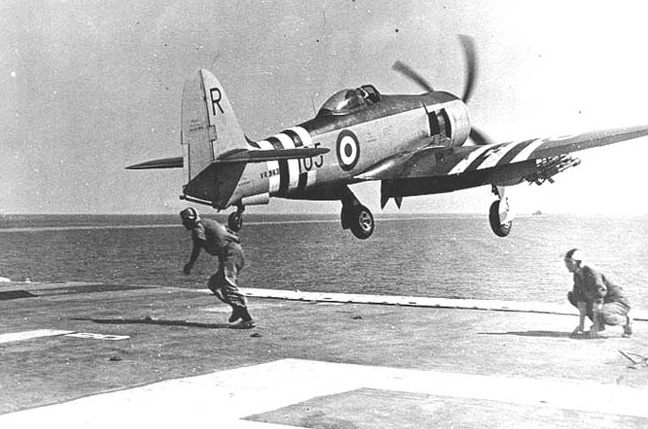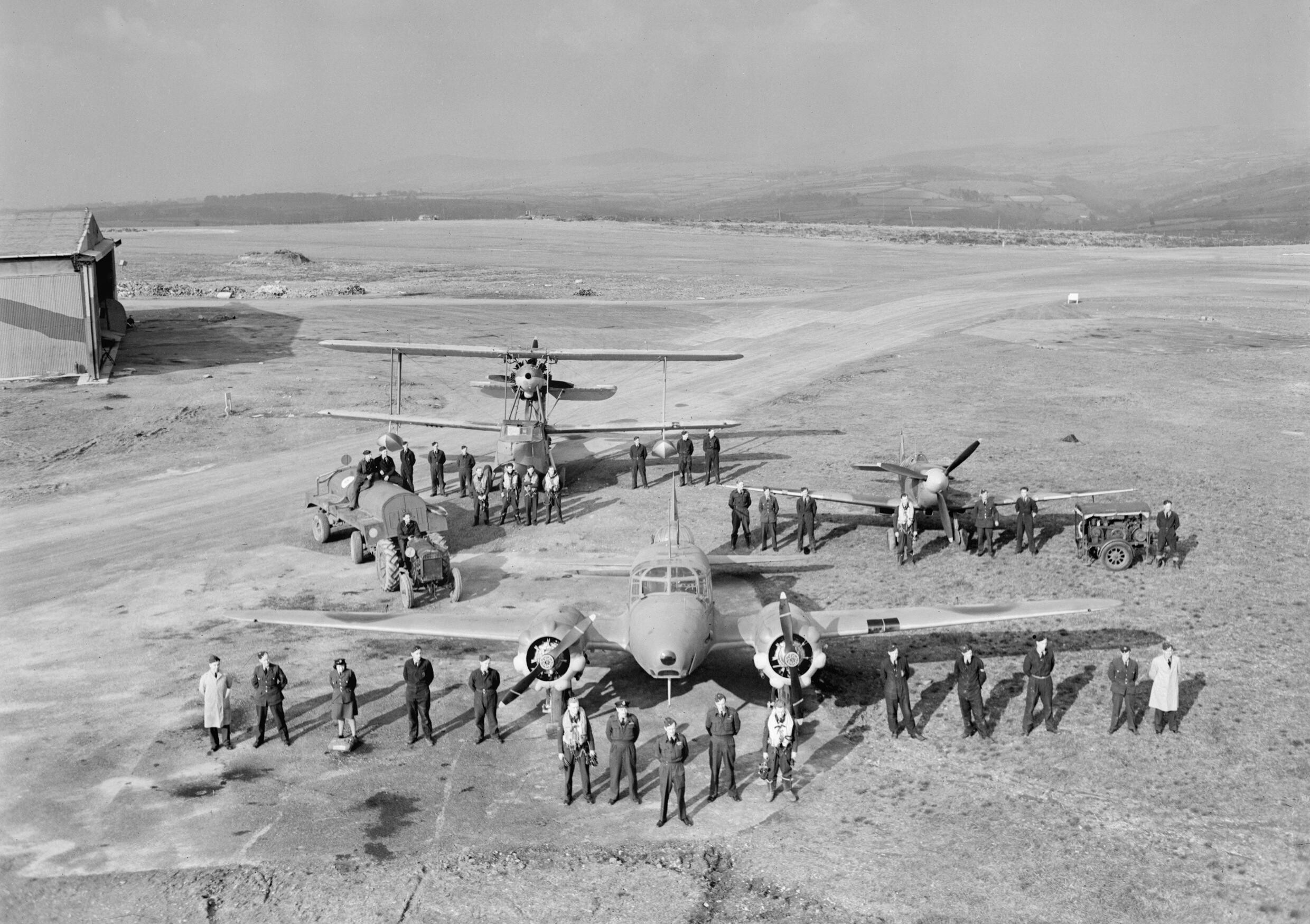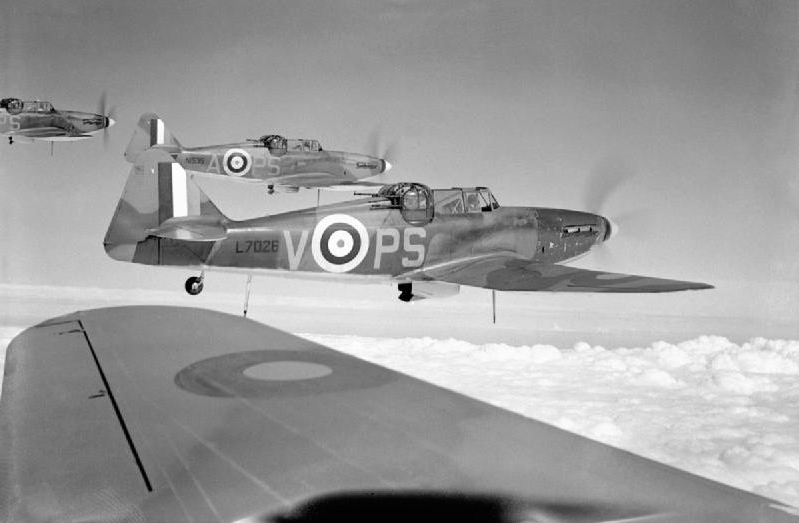|
RAF Roborough
RAF Roborough is a former Royal Air Force station in Roborough located north of Plymouth, Devon which used Plymouth City Airport as their base. History RAF Roborough began when the Air Ministry started to use Plymouth City Airport for exercises between the RAF, Royal Navy and the British Army. The Royal Navy started to use the airport in the late 1930s and was renamed RNAS Roborough however on 1 May 1942 the site was taken over by the Air Ministry for Royal Air Force use primarily for RAF Coastal Command. RNAS Roborough The Admiralty used the airfield for various duties also the airfield played an important role during the Battle of Britain coming under partial control of the No. 10 Group RAF headquarters at RAF Box and had RAF Middle Wallop as their sector station. The first squadron to use the airfield was No. 247 Squadron RAF between 1 August 1940 and 10 February 1941 flying the Gloster Gladiator II before moving to RAF St Eval on 10 February 1941 however after seven ... [...More Info...] [...Related Items...] OR: [Wikipedia] [Google] [Baidu] |
Naval Ensign Of The United Kingdom
The White Ensign, at one time called the St George's Ensign due to the simultaneous existence of a cross-less version of the flag, is an ensign worn on British Royal Navy ships and shore establishments. It consists of a red St George's Cross on a white field, identical to the flag of England except with the Union Flag in the upper canton. The White Ensign is also worn by yachts of members of the Royal Yacht Squadron and by ships of Trinity House escorting the reigning monarch. In addition to the United Kingdom, several other nations have variants of the White Ensign with their own national flags in the canton, with the St George's Cross sometimes being replaced by a naval badge omitting the cross altogether. Yachts of the Royal Irish Yacht Club wear a white ensign with an Irish tricolour in the first quadrant and defaced by the crowned harp from the Heraldic Badge of Ireland. The Flag of the British Antarctic Territory and the Commissioners' flag of the Northern Ligh ... [...More Info...] [...Related Items...] OR: [Wikipedia] [Google] [Baidu] |
RAF Box
RAF Rudloe Manor, formerly RAF Box, was a Royal Air Force station located north-east of Bath, England, between the settlements of Box and Corsham, in Wiltshire. It was one of several military installations situated in the area and covered three dispersed sites. The sites are now used by Defence Digital. History The station was established on top of quarries from which Bath Stone had been extracted. In the 1930s some of the tunnels had been converted for use as a Central Ammunition Depot. The vast caverns had some of space, divided into many smaller chambers. During the Second World War, the Operations Centre of No. 10 Group RAF was housed there in three buildings (Operations Room, Filter Room and Communications Centre), which were partially buried for protection, in a similar way to buildings for No. 9 Group at RAF Barton Hall, No. 11 Group RAF at RAF Uxbridge, No. 12 Group RAF at RAF Watnall, No. 13 Group RAF at RAF Newcastle and No. 14 Group RAF at Raigmore House in I ... [...More Info...] [...Related Items...] OR: [Wikipedia] [Google] [Baidu] |
814 Naval Air Squadron
814 Naval Air Squadron or 814 NAS, nicknamed the Flying Tigers, is a squadron of the Royal Navy Fleet Air Arm. It is currently equipped with the AgustaWestland Merlin HM2 anti-submarine warfare helicopter and is based at Royal Naval Air Station (RNAS) Culdrose in Cornwall. The squadron was formed in December 1938 and has been disbanded and reformed several times. Role and equipment 814 Naval Air Squadron operates the AgustaWestland Merlin HM2 anti-submarine warfare (ASW) helicopter and is based at RNAS Culdrose in Cornwall. In addition to its ASW role, it has capabilities in anti-piracy operations, delivery of humanitarian aid, casualty evacuation, medium lift under-slung loads (up to 3.8 tonnes), search and rescue, counter drugs and maritime patrol and security operations. The Merlin can be armed with BAE Systems Sting Ray torpedoes, Mark 11 depth charges and the Browning M3m .50 calibre machine gun. The squadron has over 200 personnel assigned to it and is the largest ... [...More Info...] [...Related Items...] OR: [Wikipedia] [Google] [Baidu] |
810 Naval Air Squadron
810 Naval Air Squadron was a Royal Navy Fleet Air Arm carrier based squadron formed on 3 April 1933 with the amalgamation of the 12 Blackburn Dart aircraft from 463 and 44 Flight (Fleet Torpedo) Flights Royal Air Force to the Fleet Air Arm. The squadron saw action during the Second World War, the Suez Crisis and the Korean War. History Pre war 810 Squadron was assigned to the aircraft carrier in May 1933 and formed part of the Home Fleet. In September that year the Darts were replaced by Blackburn Ripons, and these were in turn replaced by Blackburn Baffins in July 1934, with the entire squadron operating Baffins by November that year. The Abyssinian crisis caused ''Courageous'' and the squadron to be transferred to the Mediterranean from August 1935 to February 1936. The squadron was upgraded to use Blackburn Sharks in April 1937, and then Fairey Swordfish in September 1938. 810 Squadron was then transferred to the new aircraft carrier the following month, and had embark ... [...More Info...] [...Related Items...] OR: [Wikipedia] [Google] [Baidu] |
801 Naval Air Squadron
801 Naval Air Squadron (NAS) was a Fleet Air Arm squadron of the Royal Navy formed in 1933 which fought in World War II, the Korean War and the Falklands War. Fleet Air Arm of the Royal Air Force The squadron was formed on 3 April 1933 as part of the Fleet Air Arm, with the promotion of No. 401 Flight to squadron status. The squadron was equipped with the Fairey Flycatcher and Hawker Nimrod aboard . The Flycatchers were replaced in 1934 by the Hawker Osprey and the Nimrods were retired in 1936. The squadron was re-equipped with the Blackburn Skua and Gloster Gladiator in 1939 just before the squadron was transferred to the Admiralty. Second World War In January 1940, 801 NAS was based at RNAS Donibristle with the Blackburn Skua, playing a key role in the early part of the war with operations in Norway while deploying from the aircraft carrier . In September, 801 Squadron embarked on for raids on the northerly parts of the Norwegian coast. Following an attack on Trondheim on ... [...More Info...] [...Related Items...] OR: [Wikipedia] [Google] [Baidu] |
Airfields Of Britain Conservation Trust
The Airfields of Britain Conservation Trust (ABCT), founded 2006, is a non-profit organisation that works to preserve and protect airfields in Great Britain, as well as educating people about their history. The Trust is a registered charity. They place inscribed memorial stones on or near disused airfields, which have included a memorial at Fambridge, Essex in February 2009, at Windermere in Cumbria in 2011 and at Montrose Air Station Heritage Centre in May 2012. Other memorial locations include Harrowbeer, Hatfield, Lanark, Leavesden, Matlaske, Okehampton, Podington Podington is a village and civil parish in Bedfordshire, England, United Kingdom. The village is within the electoral ward of Harrold in the Borough of Bedford. Podington lies around northwest of Bedford and is about east of the county border ..., Swannington, Westcott and Woburn Park. References External links * Charities based in Glasgow Conservation in the United Kingdom Aviation history ... [...More Info...] [...Related Items...] OR: [Wikipedia] [Google] [Baidu] |
RAF Harrowbeer
Royal Air Force Harrowbeer or more simply RAF Harrowbeer is a former Royal Air Force station situated next to Yelverton in the parish of Buckland Monachorum, Devon, England Location RAF Harrowbeer was located approximately NNE of the city of Plymouth and approximately south of Tavistock, and also sits within the boundary of Dartmoor National Park. Roborough Rock is a tor-like igneous rock outcrop immediately south-west of the airfield (officially called 'Udal Tor') on Roborough Down, next to the border with the A386. This location created problems for the airfield during the Second World War, mainly due to bad weather. The Rock seems to have had little impact on the use of the Airfield, the only thing that was done by the RAF was the placing of a warning light on the top. There seems to be no truth in the widely-held belief that the RAF attempted to blow it up. Although sited near the village of Yelverton, it was called 'Harrowbeer' in order to distinguish it from the ... [...More Info...] [...Related Items...] OR: [Wikipedia] [Google] [Baidu] |
Fairey Barracuda
The Fairey Barracuda was a British carrier-borne torpedo and dive bomber designed by Fairey Aviation. It was the first aircraft of this type operated by the Royal Navy's Fleet Air Arm (FAA) to be fabricated entirely from metal. The Barracuda was developed as a replacement for the Fairey Albacore biplanes. Development was protracted due to the original powerplant intended for the type, the Rolls-Royce Exe, being cancelled. It was replaced by the less powerful Rolls-Royce Merlin engine. On 7 December 1940, the first Fairey prototype conducted its maiden flight. Early testing revealed it to be somewhat underpowered. However, the definitive Barracuda Mk II had a more powerful model of the Merlin engine, while later versions were powered by the larger and even more powerful Rolls-Royce Griffon engine. The type was ordered in bulk to equip the FAA. In addition to Fairey's own production line, Barracudas were also built by Blackburn Aircraft, Boulton Paul, and Westland Aircraft. T ... [...More Info...] [...Related Items...] OR: [Wikipedia] [Google] [Baidu] |
Airspeed Oxford
The Airspeed AS.10 Oxford is a twin-engine monoplane aircraft developed and manufactured by Airspeed. It saw widespread use for training British Commonwealth aircrews in navigation, radio-operating, bombing and gunnery roles throughout the Second World War. The Oxford was developed by Airspeed during the 1930s in response to a requirement for a capable trainer aircraft that conformed with Specification T.23/36, which had been issued by the British Air Ministry. Its basic design is derived from the company's earlier AS.6 Envoy, a commercial passenger aircraft. Performing its maiden flight on 19 June 1937, it was quickly put into production as part of a rapid expansion of the Royal Air Force (RAF) in anticipation of a large-scale conflict. As a consequence of the outbreak of war, many thousands of Oxfords were ordered by Britain and its allies, including Australia, Canada, France, New Zealand, Poland, and the United States. Following the end of the conflict, the Oxford continu ... [...More Info...] [...Related Items...] OR: [Wikipedia] [Google] [Baidu] |
Boulton Paul Defiant
The Boulton Paul Defiant is a British interceptor aircraft that served with the Royal Air Force (RAF) during World War II. The Defiant was designed and built by Boulton Paul Aircraft as a "turret fighter", without any fixed forward-firing guns, also found in the Blackburn Roc of the Royal Navy. In combat, the Defiant was found to be effective at destroying bombers, the role it was designed for, but was vulnerable to the ''Luftwaffe''s more manoeuvrable, single-seat Messerschmitt Bf 109 fighters. The Defiant had been designed to destroy unescorted bombers by means of beam or ventral attacks and therefore lacked forward-firing armament, that proved to be a great weakness in daylight combat with fighters. It did, however, find success when it was converted to a night fighter. It eventually equipped thirteen squadrons in this role,Cagill 2005, p. 44. compared to just two squadrons as a day-fighter, though this was mainly due to slow initial production. In mid-1942 it was replaced ... [...More Info...] [...Related Items...] OR: [Wikipedia] [Google] [Baidu] |
RAF Portreath
Remote Radar Head Portreath or RRH Portreath is an air defence radar station operated by the Royal Air Force. It has a coastal location at Nancekuke Common, approximately north east of the village of Portreath in Cornwall, England. Its radar (housed in a fibre glass or ''golf ball'' protective dome) provides long-range coverage of the south western approaches to the United Kingdom. Second World War Previously known as RAF Portreath, the station was built during 1940, opened in March 1941 and had a varied career during the Second World War, initially as a RAF Fighter Command station, from October 1941 as a ferry stop-over for aircraft bound to/from North Africa and the Middle East, as a temporary stop-over for United States Army Air Forces and Royal Canadian Air Force units, and then as a RAF Coastal Command station. By the end of the war, it had run down and in May 1950 was handed back to the government by the RAF. The following squadrons were here at some point: Units: C ... [...More Info...] [...Related Items...] OR: [Wikipedia] [Google] [Baidu] |
Hawker Hurricane
The Hawker Hurricane is a British single-seat fighter aircraft of the 1930s–40s which was designed and predominantly built by Hawker Aircraft Ltd. for service with the Royal Air Force (RAF). It was overshadowed in the public consciousness by the Supermarine Spitfire during the Battle of Britain in 1940, but the Hurricane inflicted 60 percent of the losses sustained by the Luftwaffe in the campaign, and fought in all the major theatres of the Second World War. The Hurricane originated from discussions between RAF officials and aircraft designer Sir Sydney Camm about a proposed monoplane derivative of the Hawker Fury biplane in the early 1930s. Despite an institutional preference for biplanes and lack of interest by the Air Ministry, Hawker refined their monoplane proposal, incorporating several innovations which became critical to wartime fighter aircraft, including retractable landing gear and the more powerful Rolls-Royce Merlin engine. The Air Ministry ordered Hawker ... [...More Info...] [...Related Items...] OR: [Wikipedia] [Google] [Baidu] |









